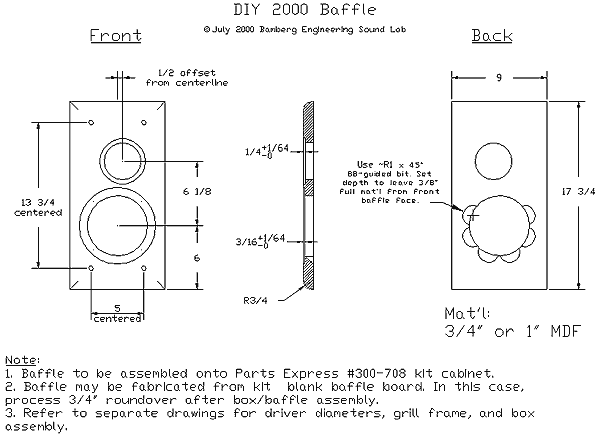I’m reading about how the acoustic centers of different drivers are often not in the same place. So take a regular flat front baffle with a tweeter and a woofer. The sound from the tweeter will reach the listener before that of the woofer. And so the sound may not appear quite as precise. One solution is to place a time delay for the tweeter into the crossover. Another solution is to have the front baffle sloped (say 10 degrees) such that the woofer is closer to the listener than the tweeter. In the Loudspeaker Design Cookbook, Dickason discusses the pros/cons of each approach to dealing with the problem and he prefers using a time delay. I’ve noticed that some commercial speakers I’ve liked have sloped front baffles. Two examples here:
So I’m thinking about sloped baffles and/or time delays for my next project. I’m wondering if any of you folks have any thoughts on the matter. Some questions and thoughts that I have for now:
-For determining the proper slope for a baffle, the book says to make a straight line from the back plate of the woofer to the back plate of the tweeter. Is this precise enough or does one need to do something fancier?
-How would one add a time delay (say ~300 microseconds for the tweeter) into a crossover? I haven’t seen too much explanation of that. And how would you determine the proper amount of delay to use without super fancy measuring gear?
Thanks!
-Jon
So I’m thinking about sloped baffles and/or time delays for my next project. I’m wondering if any of you folks have any thoughts on the matter. Some questions and thoughts that I have for now:
-For determining the proper slope for a baffle, the book says to make a straight line from the back plate of the woofer to the back plate of the tweeter. Is this precise enough or does one need to do something fancier?
-How would one add a time delay (say ~300 microseconds for the tweeter) into a crossover? I haven’t seen too much explanation of that. And how would you determine the proper amount of delay to use without super fancy measuring gear?
Thanks!
-Jon







 The Vandersteens look to be using various aspects: stepped baffle with the tweeter farthest back, narrower baffles around each driver to control diffraction, and felt as well. Interesting. Maybe the felt is needed to deal with all the diffraction issues from the stepped baffle.
The Vandersteens look to be using various aspects: stepped baffle with the tweeter farthest back, narrower baffles around each driver to control diffraction, and felt as well. Interesting. Maybe the felt is needed to deal with all the diffraction issues from the stepped baffle.


 h:
h:
Comment